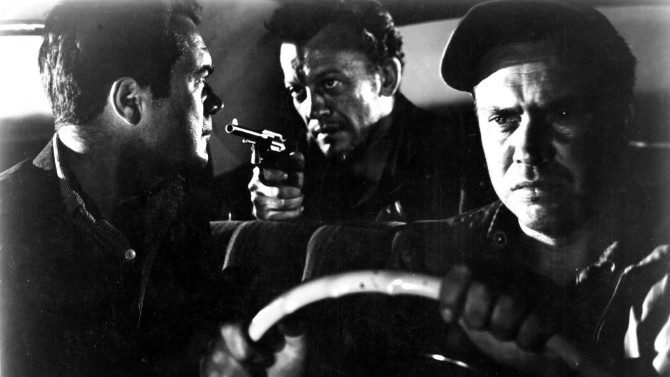Talk about an opening hook: “This is the true story of a man and a gun and a car. The gun belonged to the man. The car might have been yours – or that young couple across the aisle. What you will see in the next seventy minutes could have happened to you. For the facts are actual.” A perfect film noir introduction, the 1953 crime thriller The Hitch-Hiker, co-written and directed by Ida Lupino, is a seventy-one minute ride down a road you most definitely would not want to travel.
In a simpler time (when people still picked up hitch-hikers), Emmett Myers (William Talman – best known as District Attorney Hamilton Burger on Perry Mason) utilizes this mode of transportation to evade the police. . . murdering those kind enough to pick him up. Dumping the body (or bodies) and abandoning the car, his thumb then goes up as he plays the stranded traveller – his two newest would-be-victims are Roy Collins (Edmond O’Brien – D.O.A.; White Heat) and Gilbert Bowen (Frank Lovejoy – In a Lonely Place; House of Wax).
Using their car to evade the cops and cross the rocky, desert terrain of Mexico, he holds the pair at gunpoint while directing them across the country towards a ferry in Guaymas. Attempting every which way to escape the maniacal man, it is no use, as Myers is a wily psychopath, knowing each and every trick in the proverbial play-book. Extremely careful and with an amazing ability to sleep with one eye open, the cloak he places over the vehicle is stifling – Collins and Bowen have no choice but to go along with the roundabout plan. Will the bosom buddies be able to escape their dire predicament. . . or will they become the latest victims of the hitch-hiker killer?
Centred around three intriguing personas, William Talman builds a villain that you would not want to cross. With his bulbous eyes (one is wonky), five o’clock shadow and menacing black attire, Myers is a vile sociopath with a mission – a match for almost any situation. Quotations like: “I had a watch like this once when I was 17. Nobody gave it to me. I just took it”, or “you guys are soft. You know what makes you that way? You’re up to your neck in IOU’s. You’re suckers! You’re scared to get out on your own. You’ve always had it good, so you’re soft. Well, not me! Nobody ever gave me anything, so I don’t owe anybody!”, as well as the Rodney Dangerfield sounding line, “My folks were tough. When I was born, they took one look at this puss of mine and told me to get lost.”, each puts us in the man’s warped mind set – emphasizing his rage against the world outlook. Edmond O’Brien’s Collins is a smart, stoic individual. . . biding his time until an opportunity arises. Frank Lovejoy’s Bowen, on the other hand, is a more twitchy man, nervous and antsy when at gunpoint – a panicked guy looking for the quickest way out. Despite their very different thought processes, they are utterly loyal to each other – with Collins especially going above and beyond for his friend.
Ahead of her time, Ida Lupido holds the title of being the first woman to direct a mainstream film noir. Though most probably know her as an actress, she was also an accomplished writer, director and producer in a time where no other women was – actually, the only lady within the 1950’s studio system to do so. A strong willed woman who found herself suspended (often) by Warner Bros. (for refusing roles and revising scripts), she made sure to observe the work behind the scenes. Starting her own production company with husband Collier Young (the other co-writer of the motion picture), she cleverly fused her work with being a smart, low budget filmmaker (acting funded her passion for directing), coming up with clever ways to save money on set (she preplanned, reused sets, utilized product placements and shot in public places to reduce costs). And, her skills are on full display here, suspense and thrills built into the tightest of triangles – three men in a car, oppressed by the hot desert. Along with cinematographer great Nicholas Musuraca (Out of the Past; Cat People), they douse certain scenes with perfect shadow and light (two of the most memorable find the evil hitch-hiker’s shadow etched on the brightly sunlit road – it being bent by the stopping car, the second finds Myers’ visage in shadow when he first enters the duo’s vehicle – it is only revealed a little later), while at other moments, we almost feel the unbearable heat of the baking sun.
Inspired by a real story (Billy Cook killed six people in 1950-51 whilst on a 22 day rampage between Missouri and California), The Hitch-Hiker is a taut little film noir thriller. Another tidbit is that the story is based upon a piece by Daniel Mainwaring (who was blacklisted at the time). With real locations, sharp direction and cinematography as well as superlative performances, this is a relatively unknown noir that is well worth seeing. So, hitch a ride to see this hidden gem of a classic, and make sure that it finds its way in the docket of your playlist.



